WHY YOU SHOULD NOT SHOOT AN OSTRICH
This essay appears in Hunting & Safari Magazine
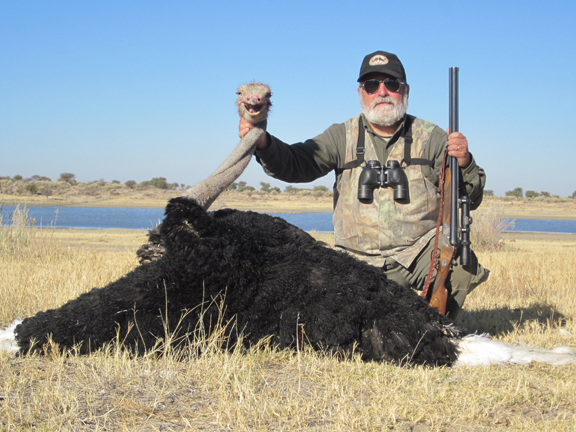
Herewith a cautionary tale for all frustrated hunters, a saga of delay, frustration and vast expense incurred, all of which was unforeseen. Beware of “cheap” trophies!
In 2013 I went to Namibia for a dangerous game hunt in the Caprivi Strip. I did get my elephant, but I had also wanted to take a hippopotamus. I did, in fact, see a hippo, on land and close enough to shoot, but in a place where I couldn't have shot it, even if I'd had my rifle with me, which I didn't at the time. So after taking the elephant, my PH and I sat for four days on the banks of the Zambezi River, where the hippopotami remained totally uncooperative.
Some people hunt hippos from a boat, but that option was out for a variety of reasons. So it boiled down to one of two options: get out to the river banks before dawn, and catch the beasts as they return to the water; or wait until they emerge at the end of their day to come and forage on land. The hunting concession for hippo was such a long way from the safari camp, even getting up at 3:00 AM wouldn’t have got us there before they went back into the water; so we elected the second method, hoping one would emerge onto land at a reasonable hour.
A “reasonable” hour in this situation meant shooting one at a time of day with enough remaining daylight to recover the body. That can be a very time-consuming ordeal. A dead hippo, assuming he’s been killed outright, sinks. After an hour or two the gases in his stomach as he starts to bloat will bring the body to the surface, where some brave person who’s not afraid of the numerous crocodiles that infest the Zambezi can put a rope on him, and the body can be dragged up on shore. The fun of trying to get a 5000 pound animal out of the water, onto the land, and into the vehicle can easily last half a day, even if everything goes well. We didn't have that option.
We didn’t dare stay out after dark. Why? Because the Caprivi is true wild Africa with many, many predators that prowl the river banks at night: and yes, there are lions. Not having any desire to have it forcibly demonstrated that we were not, after all, really at the top of the food chain, we elected to stay until about an hour before dusk, and then skedaddle.
For those four days the hippos seemed to be content to stay submerged until after we’d left. Probably they were laughing to themselves about the idiots hunting them, but whatever they were doing, never a hippo did we see, in or out of the water, the entire time. Well, these things happen. It’s why the sport is called “hunting,” not “killing.” More often than not a hunter doesn’t succeed.
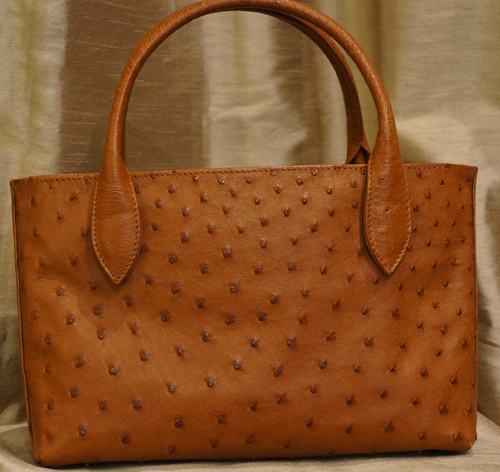 I didn’t have much interest in any other species, having taken all the plains game animals I wanted on previous hunts. But I decided a nice ostrich would be a good "consolation prize," because I could have the hide tanned and made into a purse for my wife. That would, I thought, be a touching gift, one that demonstrated not only my thoughtfulness and gratitude for a sterling woman, but one that was as personal as it could get. How many women can say they have an ostrich skin purse from a custom-slain ostrich?
I didn’t have much interest in any other species, having taken all the plains game animals I wanted on previous hunts. But I decided a nice ostrich would be a good "consolation prize," because I could have the hide tanned and made into a purse for my wife. That would, I thought, be a touching gift, one that demonstrated not only my thoughtfulness and gratitude for a sterling woman, but one that was as personal as it could get. How many women can say they have an ostrich skin purse from a custom-slain ostrich?
So upon return to the central part of the country I spent some time hunting for the "right ostrich." Big Bird is sharp-eyed and very fleet of foot: five or six fruitless attempts to stalk them convinced me that an ambush from a high seat was the way to go. Even though an ostrich is the largest bird in the world the .416 I’d used on the elephant was definitely overkill. I left it in camp and brought my drilling, whose rifle barrel is chambered for 8x57JR, a lovely caliber for medium sized animals.
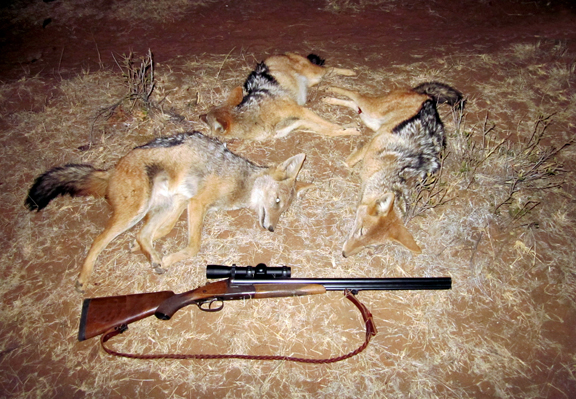 In two days in the blind all I saw was one lone female ostrich, and I let her pass. A number of obliging black-backed jackals came by to relieve some of the boredom. I’d been instructed to shoot every jackal I saw. The 8x57JR dispatches a jackal so rapidly that I suspect a few of the ones I shot still don’t know they’re dead. Sellier & Bellot’s ammunition in this caliber has a 196-grain round nosed bullet with a good bit of exposed lead. It makes an impressive exit wound in these small animals, dropping them in their tracks. I killed at least four in one evening, at ranges up to 200 meters. I can’t praise the S&B stuff too highly.
In two days in the blind all I saw was one lone female ostrich, and I let her pass. A number of obliging black-backed jackals came by to relieve some of the boredom. I’d been instructed to shoot every jackal I saw. The 8x57JR dispatches a jackal so rapidly that I suspect a few of the ones I shot still don’t know they’re dead. Sellier & Bellot’s ammunition in this caliber has a 196-grain round nosed bullet with a good bit of exposed lead. It makes an impressive exit wound in these small animals, dropping them in their tracks. I killed at least four in one evening, at ranges up to 200 meters. I can’t praise the S&B stuff too highly.
But I was still ostrich-free, and the longer I tried the more determined I became that I would take one if at all possible. On the very last day of the hunt I had more or less decided the ostrich had taken a page from the hippopotamus playbook, and it wasn’t going to happen. Then we drove into an area around a half-dried-up pan, and lo, two fine males came strutting along with that foolish loose-limbed stride only an ostrich can display. This was a major error of judgment, especially as they were entirely oblivious to our presence. I chose the larger of the two, and dropped him with one shot to his left side. He was a fine big fellow, easily 300+ pounds, with nice plumage. He would make an outstanding purse. We loaded him into the vehicle, and ho, for the taxidermist!
That’s when the fun began. Upon arrival at the shop I was told that tanning the hide would cost me well over $400. I'd thought of the ostrich as a bargain because the trophy fee was only $750 instead of the $5500 a hippo would have cost. It seemed unreasonable to me to pay more than half of the cost of the bird just to tan the skin. Then the taxidermist—who also of course had a shop in which he sold many products—suggested I buy a ready-made purse from his collection, and/or trade in my skin on one of the tanned hides he had in the shop, which had come from farmed birds. He argued that the domestic hides were far less likely to bear the scars of fighting and other damage that wild birds’ hides did, and moreover I could have my choice of colors: everything from Natural Dead-Ostrich Pale to Screaming Yellow or Violent Red.
These options made little appeal to me, because I had, when all was said and done, taken the bird’s life for my own reasons and it seemed that I owed it to the ostrich himself to use his hide for my intended purposes. I’m not terribly sentimental but I do believe that killing has to be justified in some way. The meat wasn’t going to waste: it would be eaten by the staff at my PH’s establishment. I was comfortable with that (though I did regret not getting to share the bounty, as ostrich is fine eating). And damn it, that hide was mine by right of conquest. I wasn’t about to buy a factory-made purse made from the skin of a bird no wilder than a chicken. If my wife was going to get an ostrich-skin purse at all, it was going to be made from that hide.
I was even more outraged when the taxidermist refused to give me anything for the hide I brought in. My thought was that if I were going to swap my hide for one of his, I ought really to get half price on one of his farmed hides, but no, no way that was going to happen. He was insistent that $400 was the going rate to get my own hide tanned, or to buy one of his hides. I quite failed to see the logic of this argument. I balked. The hide was in a wheelbarrow outside the shop, heavily salted, and I told the taxidermist no deal. The PH would take it back to his place and someone else would do the job at a reasonable charge.
In 2010 I’d done a safari for plains game and used a taxidermy shop run by a lady who had since semi-retired. She’d done a good job on the items I left with her and furthermore, she had some stuff I'd meant to bring back from that trip. I’d shot a baboon and wanted the skull; and had retained a foot from a Hartmann’s Mountain Zebra. A zebra’s foot and hoof differ from that of domesticated horses and I wanted a specimen to show to the veterinary students I was teaching at the time.
Unfortunately both of these species require CITES permits and veterinary clearance; there hadn't been time to get them ready to ship in 2010, so they'd sat in her shop for three years awaiting a decision on what to do. I reasoned that she could tan the hide at a more reasonable rate and simultaneously ship the older stuff with it when it was ready. So my salted bird skin went back into the vehicle and off to her shop, in care of my PH.
That was pretty much how things stood for well over a year without a word from the taxidermy lady. Finally, after making an inquiry about what was happening, I was told that yes, the hide had been tanned, that will be $250, please. That was fine, a far more reasonable price than the first taxidermist wanted. But so far I was into this bird for a thousand dollars, and I had yet to lay eyes on it. I OK’ed the price, paid another $70 in wire transfer fees, and asked her to send the hide, feathers, the baboon skull and the zebra foot back to the PH, who then contacted his shipper.
The shipper contacted me to get various papers signed to authorize him to ship the stuff. That’s a pretty standard process, but the back-and-forth took another two months. Finally I got his bill: $600 plus more wire transfer fees. By then I’d invested $1705. The shipper couldn’t just put it on the next plane out to Roanoke, Virginia, 40 miles from my home. Oh, no: that $1705 would get it as far as the Baltimore-Washington International Airport. At that point it had to be “cleared” through Customs by a broker.
Baltimore is the nearest suitable airport to my home, because not all entry points have the proper licensing by the US government to handle such items. BWI was the nearest one, and it was 6 hours' drive from where I live. Neither could I just show up at the airport and claim it, it had to go through a customs broker. You can’t just bring animal parts from Africa into the USA: they have to be certified in the country of origin as being legally taken and have veterinary approval for export. They must be routed through a Customs office located in an airport with the proper authorization and the right US Department of Agriculture and Fish and Wildlife Service permits to handle African animal specimens, who check to make everything has been ticked off on the proper forms. Most especially the USDA is very, very wary about birds: avian diseases pose a real threat to American agriculture and bird imports are regulated even more tightly than imports of comparatively benign articles such as explosives or illegal drugs. Threading the way through the paperwork maze does in fact require a broker's knowledge of the system.
More paperwork, this time to give the customs broker who received it the shipper permission to bring it in on my behalf. The broker very kindly agreed to ship it to my home. Of course, his services weren't free: the broker hit me up for another $663, and I received this little billet-doux along with the bill, from a tannery, of all places, located in Pennsylvania:
We were asked by XYZ Global Freight to assist you in your trophy shipment clearances. We offer an import service where we work with…[your] brokerage firm at BWI, clearing your shipment and personally picking up your shipment and bringing it back to the tannery. The average cost for providing these services have been approximately $650 - $700. Then once it is cleared and at the tannery, if you would so elect, we can tan your hides and prepare them for yourself or your taxidermist.
The tannery quoted me a price of “about $600” over and above the customs broker’s charge. Now, the hide had been tanned months before in Namibia, so I immediately contacted the customs broker and flatly refused to pay this ridiculous and totally unnecessary additional charge.
By that time I was up to a nice fat $2403 in expenses. For that price I could have bought a round trip ticket to Namibia and brought home a live ostrich in my checked baggage. The customs broker, once it was explained that we were talking about a fully tanned hide, cordially told the tannery to forget it, and then very politely offered to ship the hide to my home, for a mere $400 more. As the bill edged towards three thousand dollars I was pretty hot under the collar, but hey, I murdered that bird and my wife was looking forward to the purse. So I accepted their kind offer.
A couple of weeks later, a full-sized tractor-trailer rig came to a stop on my suburban street. The rear door was rolled up and I was handed its entire contents: a package that was all of 55x46x20 cm in size and weighed 5 kilograms. So I didn’t crack the $3000 mark…but the delivery was made on August 2, 2014, which was nearly a year and a half after I’d shot the bird!
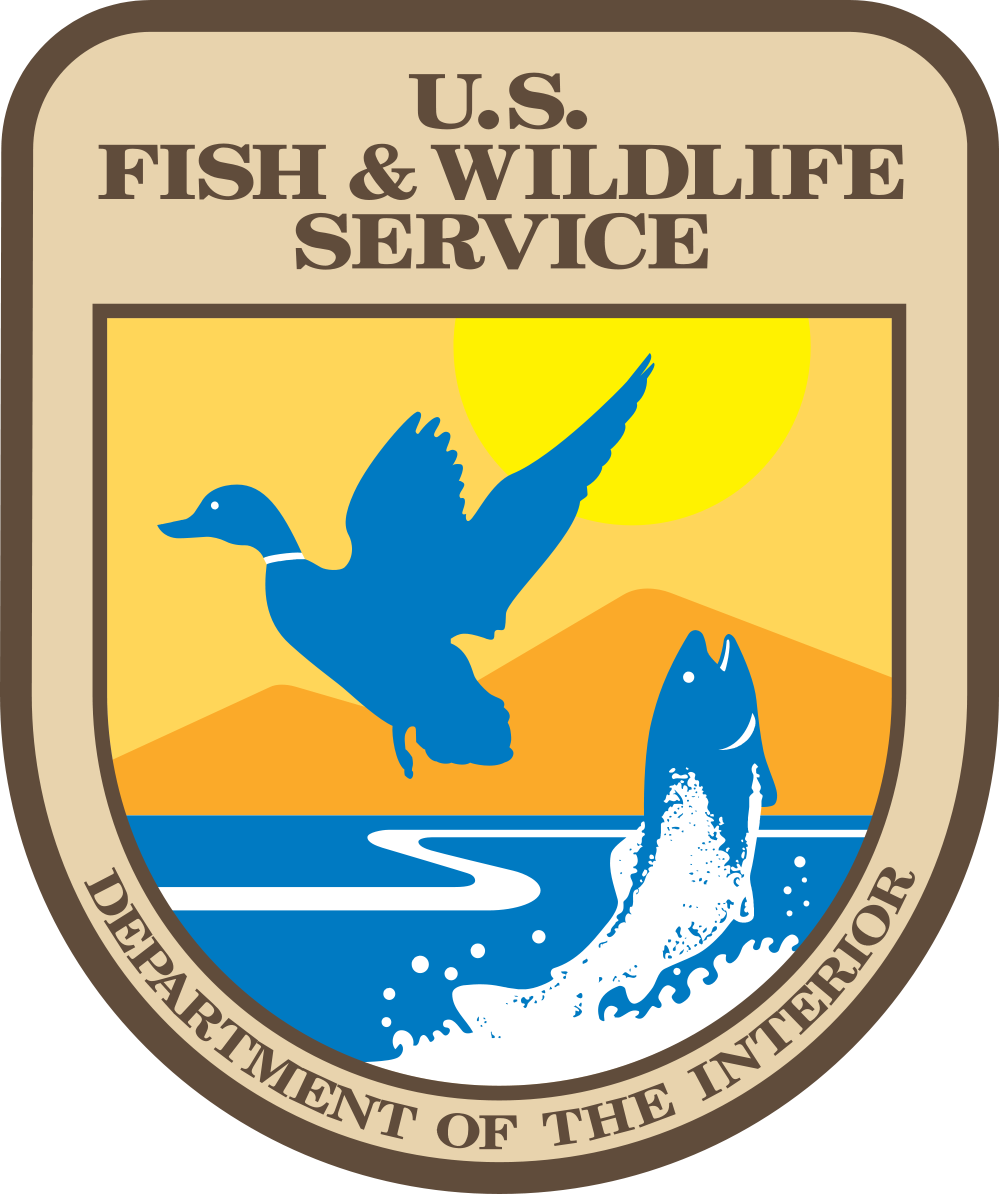 That was not the end of the story, however. I still had to contend with the labyrinth of the US Fish & Wildlife Service and the Customs Service at BWI.
That was not the end of the story, however. I still had to contend with the labyrinth of the US Fish & Wildlife Service and the Customs Service at BWI.
The baboon and the foot bones from the Hartmann’s Mountain Zebra I’d shot on my 2010 trip remained to be dealt with. For reasons known only to God and the US government, both of these species require a CITES permit. Now, I had received a permit to bring home the zebra hide (in 2011) but the foot bones had stayed in Namibia because the taxidermist had to process them differently. As to the baboon, she simply forgot to include that in the package she sent in 2010.
Since I needed a CITES permit for the baboon skull, she went ahead and did the paperwork for it, but didn’t bother to ask for a second permit for the zebra bones. Because, I was assured, the previously-issued permit for the hide would cover the bones as well, since they were from the same animal.
Oh yeah? When the package passed into the benign hands of the US Customs people, they pounced on the zebra bones. The baboon skull was okey-dokey, and could be sent to me. But the bones…uh-uh. The original permit was null and void, having expired. Nor could a new one be issued. The bones were seized as a threat to the safety and well-being of the American Republic, and I was issued a citation and a “seizure notice,” which I was welcome to challenge if I cared to take on the full weight and majesty of the United States. I settled for what I could get, and while I was pretty honked off about those bones, at least I still had the hide. I had retired from the vet school in 2014, so I no longer needed the bones. And I had the skull from the baboon, who had died three years before.
The lesson here—I offer my painfully-gained insight to my readers gratis—is that there are hidden costs in a safari. Things you never think about while you’re enjoying the bush and fulfilling a lifelong dream of an African hunt. Taxidermy has to be included in the budget.
Moreover, there is no saving money on it. If it’s going to be done it’s going to cost far more than you might imagine and can easily exceed the trophy fee, even for an expensive animal like a Cape Buffalo. While very high-quality work is done in African studios at a price much lower than taxidermy of comparable quality would cost in the USA (about a third to a half, in fact) any savings will get eaten up by the shipping and customs costs. Not all predators have four legs and live in the bush: some of them have cushy air-conditioned offices in Windhoek, Johannesburg, and Baltimore.
It’s possible to ship salted and dipped hides and heads to the USA and have the taxidermy done here. But that’s not any less expensive: the processing fees and shipping costs are the same whether the trophies have been fully mounted or not.
Now, as to the purse. Love is gentle, love is kind, love never fails, and my wife is a woman who deserves the best. I know a custom leatherworker in this area who can do the job. She has no “need to know” what the purse actually cost. But…a month or two ago we were in a very up-scale shop in Vancouver and I saw a stunning ostrich-hide purse for all of $800. I offered to buy it for her and was told, “No! That’s FAR too expensive!” Nothing I could say, not even the pleadings of the sales lady (who was on commission) and her repeated reductions of price could move my wife to allow me to buy the purse.
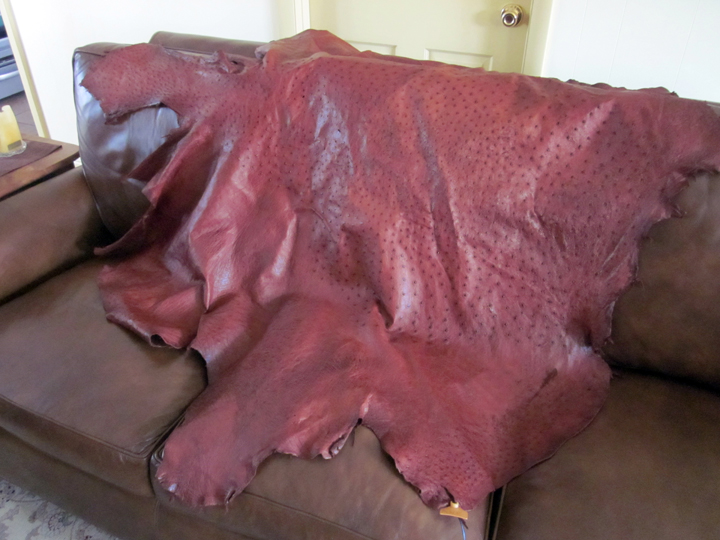
The lady taxidermist did a beautiful job on the ostrich hide, which now graces the back of a piece of furniture, an ornamental and very expensive sort of slip cover. As to the baboon, there isn’t a whole lot that can be done with a baboon skull. My original intent was to put it on display in my faculty office. Instead I wired it up into a nice night light, probably the most expensive night light in the world, when you come right down to it.
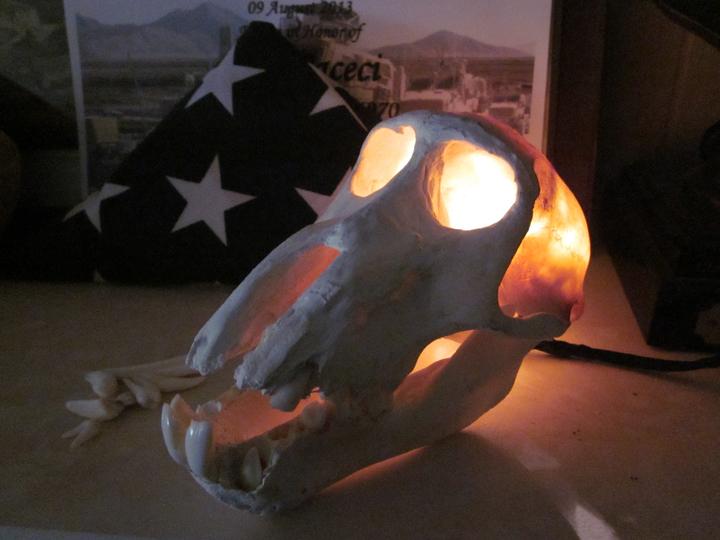
Henceforth I'll stick to elephants. Since by law you can't bring any elephant parts back to the USA, there are no taxidermy costs. No more ostriches for me.
| HUNTING | GUNS | DOGS |
| FISHING & BOATING | TRIP REPORTS | MISCELLANEOUS ESSAYS |
| CONTRIBUTIONS FROM OTHER WRITERS|
| RECIPES |POLITICS |